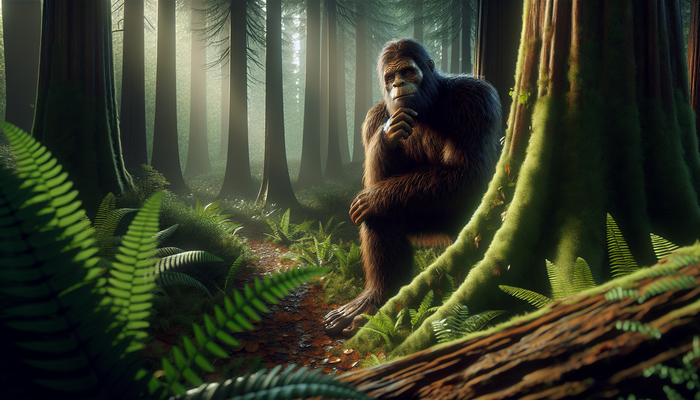Exploring Cryptids and Human Evolution: Unraveling the Myths and Realities

By Ava Martinez, Cryptozoologist
The Nature of Cryptids
At its core, the term "cryptid" stems from the Greek word "kryptos," meaning "hidden" or "secret." In the context of cryptozoology, a cryptid is an animal whose existence is unproven, with eyewitness accounts and anecdotal evidence serving as the primary basis for their alleged existence. These creatures often possess characteristics that set them apart from confirmed animal species:
- They lack concrete scientific proof, despite numerous reported sightings and encounters.
- They are frequently described as large, fearsome, and possessing an air of the uncanny—often exhibiting humanoid features or resembling exaggerated versions of known animals.
- Cryptids are typically associated with remote, inaccessible regions, such as dense forests, uncharted waters, or isolated mountain ranges.
The study of cryptids falls under the domain of cryptozoology, a field that remains on the periphery of mainstream biology. Cryptozoologists rely heavily on eyewitness testimonies, historical accounts, and circumstantial evidence in their pursuit of these hidden animals. While some researchers approach the subject with a degree of skepticism, others are driven by a fervent belief in the existence of these creatures and a desire to validate their reality through rigorous investigation.
It's important to note that cryptids exist on a spectrum, ranging from sightings of out-of-place animals to encounters with mythical humanoids and supernatural entities. On one end of the spectrum, we find reports of big cats roaming the British countryside or tales of large, unidentified primates in North America. These cryptids, while extraordinary, are not beyond the realm of biological possibility. On the other hand, creatures like the Mothman or the Jersey Devil venture into the domain of the paranormal, blurring the lines between flesh and fantasy.
Historical Context and Cultural Significance
The fascination with cryptids is not a modern phenomenon. Throughout history, cultures around the world have shared stories of strange and mysterious creatures. The ancient Greeks spoke of winged serpents, while medieval bestiaries described fantastical beings that blurred the lines between fact and fiction. These early accounts laid the groundwork for a more systematic approach to investigating unknown animals, culminating in the establishment of cryptozoology as a field in the mid-20th century.
Folklore plays a significant role in the narratives surrounding cryptids. Many of these creatures are deeply embedded in the cultural fabric of the regions they inhabit. For instance, the Yeti, or Abominable Snowman, is a prominent figure in Himalayan folklore, often depicted as a guardian of the mountains. Similarly, the Chupacabra, a creature said to drain the blood of livestock, has become a symbol of fear and intrigue in Latin American cultures.
These stories often reflect the values, fears, and beliefs of the societies that tell them. They serve as cautionary tales, warning against the dangers of venturing too far into the unknown or transgressing the boundaries of the human realm. In this way, cryptids can be seen as cultural archetypes that embody our collective anxieties and desires.
Cryptids as Reflections of Human Evolution
The study of cryptids can provide valuable insights into human evolution. As we explore the characteristics and behaviors attributed to these creatures, we may uncover parallels with our own evolutionary history.
Bigfoot: The Missing Link?
One of the most famous cryptids, Bigfoot, has often been associated with the idea of a "missing link" in human evolution. Descriptions of Bigfoot as a large, hairy humanoid creature have led some to speculate that it may represent a surviving population of ancient hominids, such as Neanderthals or even a yet-undiscovered species closely related to modern humans.
The notion that Bigfoot could be a remnant of our evolutionary past is supported by the discovery of other hominid species, such as Homo floresiensis, a small, primitive human relative that lived on the island of Flores in Indonesia until about 12,000 years ago. The existence of such species challenges the linear narrative of human evolution, suggesting that multiple hominid species coexisted and interacted with one another.
Dr. Jeff Meldrum, a professor of anatomy and anthropology at Idaho State University, has spent years studying Bigfoot and its potential evolutionary significance. He argues that the creature's reported physical characteristics, such as its large size and bipedal gait, could be adaptations to a forest environment. Meldrum suggests that Bigfoot might represent a surviving population of a species like Gigantopithecus, a massive ape that lived in Asia until about 100,000 years ago.
While the existence of Bigfoot remains unproven, the pursuit of this cryptid has led to valuable discussions about human evolution and the potential for undiscovered primate species. It challenges us to consider the gaps in our knowledge and the possibility that relict populations of ancient hominids could have survived into modern times.
The Yeti: Adaptation to Extreme Environments
The Yeti, often described as a large, ape-like creature inhabiting the Himalayan region, offers another intriguing perspective on human evolution and adaptation. Some researchers propose that the Yeti may represent a form of human adaptation to extreme environments. Just as modern humans have evolved to thrive in diverse habitats, the Yeti could be seen as a symbol of our ability to adapt to harsh conditions.
The idea that the Yeti could be a surviving population of Gigantopithecus adds another layer to this narrative. If the Yeti is indeed a descendant of this ancient species, it raises questions about the survival of other hominids in isolated environments, much like the way Homo floresiensis thrived on Flores.
Reinhold Messner, a renowned mountaineer and explorer, has spent years investigating Yeti sightings in the Himalayas. His research led him to conclude that the Yeti is likely a misidentified Tibetan brown bear. However, Messner's work highlights the importance of considering local wildlife and human perceptions when studying cryptids. The Yeti legend, whether based on a real creature or not, reflects the human capacity for storytelling and our attempts to make sense of the unknown in extreme environments.
The Chupacabra: Ecological Change and Cryptid Evolution
The Chupacabra, a creature often described as a small, reptilian beast, has become a symbol of ecological change in Latin America. Reports of livestock being drained of blood have led to speculation about the Chupacabra's origins, with some suggesting it may be a misidentified animal, such as a coyote suffering from mange.
This connection between the Chupacabra and ecological change highlights the impact of human activity on wildlife. As habitats are altered and species are pushed to the brink of extinction, the emergence of cryptids may reflect our fears about the consequences of environmental degradation.
Benjamin Radford, a skeptic and investigator of paranormal claims, has extensively researched the Chupacabra phenomenon. His work suggests that the creature's description has evolved over time, influenced by media portrayals and cultural expectations. This evolution of the Chupacabra myth demonstrates how cryptid narratives can adapt to changing social and environmental conditions, reflecting our evolving relationship with the natural world.
The Science Behind Cryptids
While the existence of cryptids remains unproven, scientific inquiry into their potential origins can yield fascinating insights. Advances in genetics and technology have opened new avenues for exploring the possibility of undiscovered species.
DNA Analysis and Cryptid Research
Recent studies have employed DNA analysis to investigate alleged cryptid samples. For instance, a study conducted by Oxford University and the Lausanne Museum of Zoology analyzed hair samples purported to come from the Yeti. The results revealed that the samples belonged to known species, primarily bears, highlighting the importance of genetic testing in separating fact from fiction in cryptid research.
This approach not only helps to debunk myths but also underscores the need for rigorous scientific methodologies in the study of cryptids. By applying the principles of genetics and evolutionary biology, researchers can better understand the potential relationships between cryptids and known species.
Dr. Bryan Sykes, a geneticist at the University of Oxford, led a project to collect and analyze DNA from alleged Yeti and Bigfoot samples. While his team didn't find evidence of unknown primate species, they did identify several interesting bear species, including an ancient polar bear lineage. This research demonstrates how the pursuit of cryptids can lead to unexpected scientific discoveries and contribute to our understanding of biodiversity.
The Role of Technology in Cryptozoology
Modern technology has revolutionized the search for cryptids. Camera traps, remote sensing, and environmental DNA (eDNA) analysis have become essential tools for researchers. These technologies allow scientists to monitor wildlife in remote areas and gather evidence without disturbing the natural environment.
For example, eDNA analysis can detect the presence of elusive species in aquatic environments by analyzing genetic material left behind in water samples. This method has the potential to uncover previously unknown species and contribute to our understanding of biodiversity.
Dr. Todd Disotell, a biological anthropologist at New York University, has used advanced DNA sequencing techniques to analyze alleged Bigfoot hair samples. While he hasn't found evidence of an unknown primate, his work demonstrates how cutting-edge technology can be applied to cryptozoological questions, potentially leading to new insights in evolutionary biology and genetics.
Cryptids and Human Psychology
The allure of cryptids is not solely rooted in biology; it also taps into the complexities of human psychology. Our fascination with these creatures reflects deeper cultural narratives and psychological processes.
The Psychology of Belief
Belief in cryptids often stems from a combination of cultural influences, personal experiences, and psychological factors. Eyewitness accounts, while compelling, are notoriously unreliable, as memories can be distorted by time, emotion, and external influences. The power of suggestion and cultural expectations can shape how individuals interpret their experiences, leading to the reinforcement of preexisting beliefs about cryptids.
Dr. Christopher French, a psychologist at Goldsmiths, University of London, has studied the psychology of paranormal beliefs, including belief in cryptids. His research suggests that factors such as pattern recognition, agency detection, and the need for meaning and control can contribute to cryptid sightings and beliefs. Understanding these psychological mechanisms can help explain why cryptid narratives persist even in the absence of concrete evidence.
Cryptids as Cultural Archetypes
Cryptids serve as cultural archetypes that embody our fears and desires. They challenge the boundaries between the known and the unknown, the human and the animal, and the natural and the supernatural. By examining the narratives surrounding these creatures, we can gain insights into the values and beliefs of the societies that create them.
For example, the Jersey Devil, a creature said to inhabit the Pine Barrens of New Jersey, has become a symbol of local identity and pride. Its legend reflects the region's history and cultural heritage, serving as a reminder of the mysteries that still exist in our world.
Dr. David Hufford, a folklorist and professor emeritus at Penn State College of Medicine, has studied the cultural significance of cryptids and other supernatural beliefs. His work on the "Old Hag" phenomenon, a sleep paralysis experience often associated with cryptid encounters, demonstrates how physiological experiences can be interpreted through cultural lenses, giving rise to enduring legends.
Conservation Implications of Cryptid Research
The search for cryptids can have positive implications for conservation efforts. As cryptozoologists and enthusiasts venture into remote areas in search of elusive creatures, they often bring attention to ecosystems that might otherwise remain overlooked. This increased awareness can lead to greater efforts to protect these habitats and the species that inhabit them.
For instance, investigations into the Mokele-mbembe, a supposed sauropod-like creature said to inhabit the Congo Basin, have drawn attention to one of the world's largest and most biodiverse tropical forests. The publicity surrounding cryptozoological expeditions has helped to spotlight the need for conservation in this ecologically crucial region.
Dr. Karl Shuker, a zoologist and cryptozoologist, has written extensively about the conservation implications of cryptid research. He argues that the search for unknown animals can lead to the discovery of new species and the rediscovery of animals thought to be extinct. This perspective highlights the potential for cryptozoology to contribute to biodiversity conservation and ecological research.
The Future of Cryptids and Human Evolution
As we look to the future, the study of cryptids and their potential connections to human evolution remains a captivating field. While the existence of these creatures may never be definitively proven, their impact on culture, science, and our understanding of the natural world is undeniable.
The ongoing discovery of new species serves as a reminder that our understanding of biodiversity is far from complete. As scientists continue to explore remote and understudied ecosystems, the possibility of uncovering new and unexpected species remains tantalizingly close.
The case of the saola, a large bovine discovered in Vietnam in 1992, illustrates how cryptids can sometimes turn out to be real animals. This elusive creature was once considered a cryptid, but its discovery has spurred conservation efforts in the Annamite Mountains, highlighting the importance of protecting biodiversity.
Dr. Jane Goodall, the renowned primatologist, has expressed openness to the possibility of undiscovered primate species. Her perspective reminds us that even experts in the field of human evolution and primate behavior recognize the potential for surprising discoveries.
The intersection of cryptids and human evolution invites us to embrace the unknown and challenge our assumptions about the natural world. While many cryptids may remain firmly in the realm of legend, the scientific and cultural impacts of their pursuit are undeniably real.
As we continue to explore the uncharted corners of our planet, the legacy of cryptozoology reminds us to approach the unknown with an open mind and a spirit of inquiry. The stories of cryptids serve as a testament to human curiosity and the never-ending quest for understanding our world and our place within it.
Whether or not we ever discover a living Bigfoot or a Yeti, the exploration of these creatures enriches our understanding of ourselves and our place in the natural world. Cryptids may be hidden, but they illuminate the complexities of human evolution, culture, and the mysteries that still await us in the shadows of our planet's most remote regions.
In the end, the study of cryptids is not just about finding mythical beasts; it's about pushing the boundaries of our knowledge, challenging our preconceptions, and embracing the wonder and mystery that still exists in our world. As we continue to unravel the myths and realities surrounding these elusive creatures, we may find that the greatest discoveries lie not in the creatures themselves, but in what they reveal about our own evolution, both biological and cultural.
From Bigfoot to UFOs: Hangar 1 Publishing Has You Covered!
Explore Untold Stories: Venture into the world of UFOs, cryptids, Bigfoot, and beyond. Every story is a journey into the extraordinary.
Immersive Book Technology: Experience real videos, sights, and sounds within our books. Its not just reading; its an adventure.



























